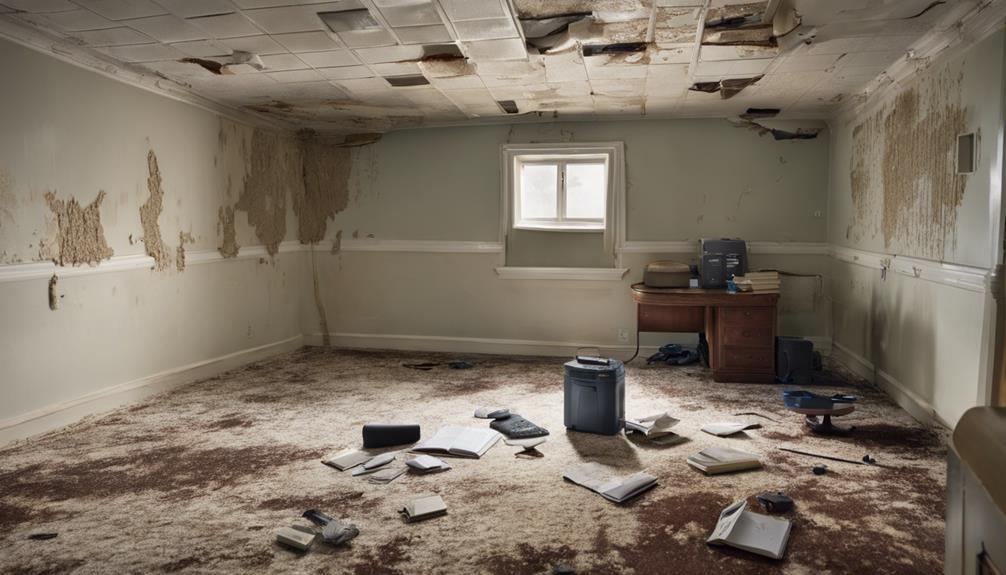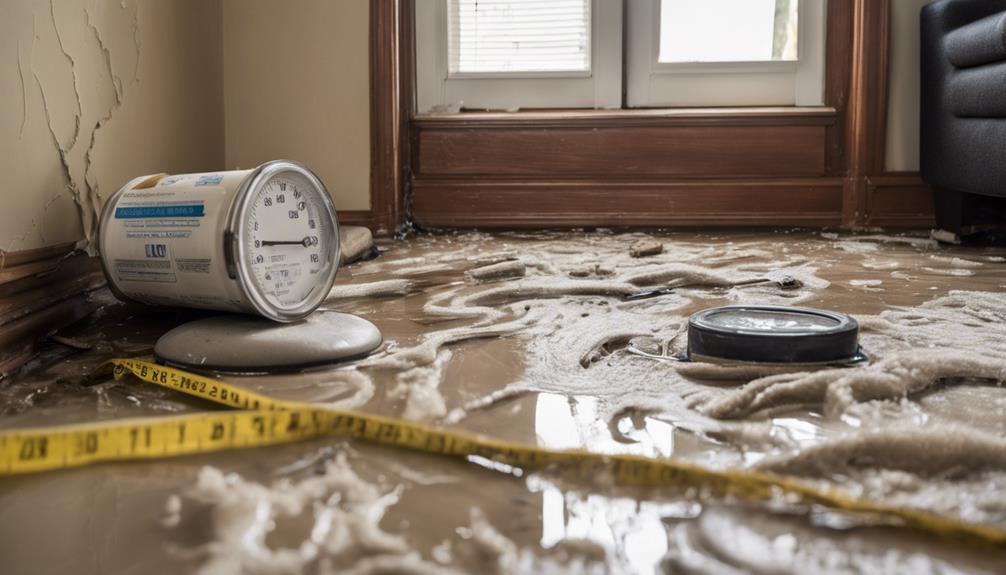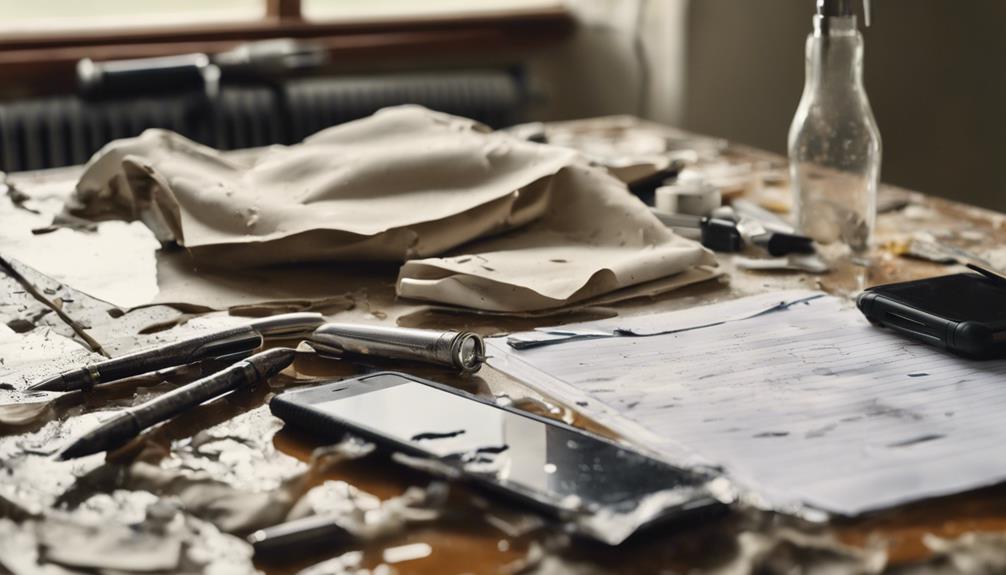
To talk to an insurance adjuster about water damage, start by gathering your documentation. Take clear photos of the damage and log the details of your interactions. Know your policy—understand what's covered and any limitations. When you connect with the adjuster, calmly share your evidence and discuss the source of the water. Ask questions about the claims process and coverage specifics. It's also smart to keep a record of everything discussed. Staying organized and informed will help you negotiate effectively. If you keep going, you'll discover more tips for navigating this complex process.

What should you do first after experiencing water damage? Start by identifying the source and, if it's safe, stop the flow, like shutting off the main water valve.
Next, document the damage thoroughly. Capture detailed photographs and videos of the affected areas and items; these will serve as crucial visual evidence for your insurance claim. It's also important to review your insurance policy for coverage details, as understanding your insurance coverage for water damage can help you navigate the claims process more effectively.
Once you've documented the damage, it's time to mitigate further damage. Dry wet areas and ensure proper air circulation to prevent mold growth, which can start within 24-48 hours.
After taking those initial steps, contact your insurance company promptly. Most providers offer 24/7 claim reporting, allowing you to kick off the insurance claim process without delay.
As you progress, keep thorough records of all actions taken. Save receipts for any temporary repairs or mitigation efforts, as these will support your claim submission when the claims adjuster reviews your case.
Understanding your insurance coverage is crucial after experiencing water damage. Start by reviewing your insurance policy to identify the specific coverage limits and exclusions related to water damage claims. Many policies only cover sudden and accidental incidents, while neglect or gradual damage may not be included. In fact, 25% of home insurance claims were due to water damage in 2018, so grasping your coverage is vital.
Typically, coverage for water damage from non-flood sources is included in standard policies, but it's essential to double-check your policy for details. Familiarize yourself with the difference between Actual Cash Value (ACV) and replacement cost coverage, as this affects the payout you'll receive for damaged items.
When obtaining repair estimates, ensure you have a clear understanding of what your policy covers. Additionally, if your home becomes uninhabitable due to water damage, your policy might cover additional living expenses, so look for any related provisions.
When negotiating settlement offers, being well-informed about your insurance coverage and limitations will empower you to advocate effectively for your needs.

How can you ensure your water damage claim is processed smoothly? Start by thoroughly documenting water damage. Capture clear photographs and videos of all affected areas and items, making sure every detail is visible for the claims process. This visual evidence is crucial when you communicate with the insurance adjuster.
Next, maintain a detailed log of all interactions with the insurance company. Note the dates, times, and names of representatives you speak with; this can support your claim later. Don't forget to keep receipts related to any damage mitigation efforts, such as temporary repairs and professional cleaning services, as these documents will help you seek reimbursement.
As you assess the damage, document any visible and unseen issues over time, especially areas prone to mold or deterioration that might escape the adjuster's initial inspection.
Lastly, provide a comprehensive statement detailing the extent of the damage. Include descriptions of affected materials, their conditions, and a list of necessary repair work. This thorough approach will help prevent any additional damage to your claim and ensure a smoother process with your insurance company.
Once you've documented the water damage thoroughly, the next step involves effectively communicating with the insurance adjuster. Clear and direct communication can significantly impact your water damage claim outcome. Here are three key points to keep in mind:
Remember to maintain a professional and respectful demeanor during discussions. It fosters better communication and cooperation with the adjuster.
Additionally, keep a log of all interactions, noting dates, times, and content of conversations. This documentation can be invaluable in tracking your insurance claims and understanding the claims process, ultimately leading to a satisfactory settlement offer.

Asking the right questions during your conversations with the insurance adjuster can make a big difference in your claim process.
Start by inquiring about the timeline for receiving payment advances for both structural and content damage. This information can significantly impact your restoration efforts.
Next, ask for a precise estimation of the building loss amounts, so you understand the potential coverage you can expect for repairs.
It's also essential to seek clarification on specific coverage details and limitations in your homeowners policy. Knowing what's included in your water damage claim is crucial.
Confirm who'll assist you in detailing claims for all damaged items; this can help streamline the process and ensure all losses are accounted for.
Navigating the claims process can feel overwhelming, but knowing the steps to take can simplify it significantly. Here's a quick guide to help you through:
Throughout this process, maintain open communication with the adjuster. Provide any requested information promptly and keep detailed records of all interactions.
If the initial settlement offer seems low, don't hesitate to negotiate using your documentation. Remember, adjusters often rely on pricing guides that may not reflect local repair costs accurately, so advocate for yourself to ensure you receive fair compensation.

When handling disputes and settlements, it's crucial to understand your coverage terms and know exactly what damages you need to document.
If you receive a settlement offer that seems low, gather evidence to negotiate effectively.
Keeping detailed records of all interactions with the adjuster will also strengthen your position.
Understanding coverage terms in your insurance policy is crucial for effectively handling disputes and settlements with an adjuster. Knowing these terms will empower you to advocate for yourself during negotiations. Here are three key aspects to consider:
If disagreements occur regarding the settlement amount, don't hesitate to consult a public adjuster. They can help negotiate a fair resolution based on your coverage terms.
Always be prepared to present solid evidence of the damage, like photographs and repair receipts, to strengthen your case. By being well-informed and proactive, you'll increase your chances of a successful outcome when dealing with your insurance adjuster.
Thoroughly documenting damage is essential for a successful insurance claim, especially when disputes arise. Start by taking detailed photographs and videos of the water damage, ensuring you capture the extent of the destruction, including hidden areas. This visual evidence will support your claim effectively.
Don't forget to keep a record of all communications with the insurance company, noting dates, times, and the names of representatives. This creates a clear timeline of your interactions, which can be vital during disputes.
Additionally, maintain receipts for all expenses related to mitigation efforts, like temporary repairs and professional cleaning. These costs may be eligible for reimbursement in your settlement. Document the damages with descriptive notes, highlighting specific issues such as mold growth or structural damage. This information is crucial for the adjuster's evaluation.
If a dispute arises regarding the settlement amount, be prepared to present your documented evidence, including estimates from contractors and detailed lists of damaged items. This thorough documentation will strengthen your position and help you negotiate a fair resolution to your claim.
Negotiating settlement offers can feel daunting, but it's crucial to approach the process with confidence and preparation. Understanding your position can make a significant difference in the outcome. Here are three key steps to help you navigate the negotiation process effectively:
If the initial settlement offer seems insufficient, calmly present your evidence to advocate for a higher payout.
When you're dealing with challenges in your insurance claims, seeking additional resources and support can make a significant difference.
If you're facing difficulties with your insurance company regarding water damage claims, consider reaching out to the California Department of Insurance. They regulate the insurance industry and can help protect your rights during claims disputes.
Utilizing a public adjuster can also be beneficial; these professionals have expert negotiation skills and understand homeowners insurance policies inside and out, potentially maximizing your claim payouts.
It's essential to keep thorough documentation of all interactions with your insurance company. This documentation can support your claims and help resolve disputes effectively.
If you encounter unfair treatment or misconduct from insurance agents, report it to the California Department of Insurance. They offer resources for understanding your insurance-related inquiries.
Additionally, take advantage of free consultations often available for homeowners navigating the claims process. This support can guide you toward obtaining any additional compensation you may deserve.
With the right resources, you can effectively tackle your water damage claims and navigate the complexities of the insurance landscape more confidently.
When talking to a home claims adjuster, avoid common mistakes like admitting fault or discussing emotional responses.
Don't let adjuster tactics throw you off; stick to the facts. Factual inaccuracies can hurt your claim, so be clear and precise.
Watch for documentation errors and don't overlook your policy limits.
Always have repair estimates ready, and don't rush through claim timelines—patience can lead to a better outcome for your situation.
Insurance for water damage typically covers sudden incidents, like burst pipes, under water damage coverage.
When filing a claim, be aware of the types of water damage; clean water is usually covered, while gray and black water may have exclusions.
Documenting proof of damage is crucial, as is understanding deductible considerations and restoration costs.
Know the claim filing process and timeline expectations to navigate your policy exclusions effectively and ensure a smoother experience.
Your water damage claim might be denied for several common reasons.
If you've got maintenance issues or fail to report the damage in a timely manner, that could lead to problems.
Policy exclusions can also come into play, especially if the damage falls under lack of coverage.
Improper documentation or prior claims might raise red flags, while negligence claims could further complicate your situation.
Always ensure you understand your policy to avoid these pitfalls.
To make a successful water leak claim, start by documenting the damage thoroughly.
Gather your repair estimates and keep all receipts handy.
Review your policy coverage to understand what's included.
Adjust your expectations based on timeline factors, as claims can take time.
Provide clear documentation tips, like photos and logs of communications.
In conclusion, talking to an insurance adjuster about water damage doesn't have to be overwhelming. By understanding your coverage, documenting everything, and asking the right questions, you'll be better prepared to navigate the claims process. Remember, clear communication is key to resolving any disputes and securing a fair settlement. Don't hesitate to seek additional resources if you need help. You've got this, and your home deserves the best care!